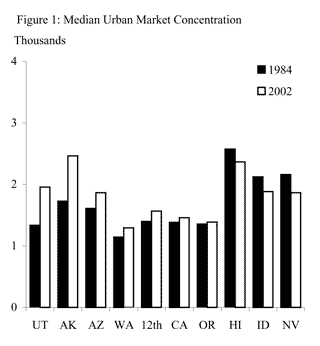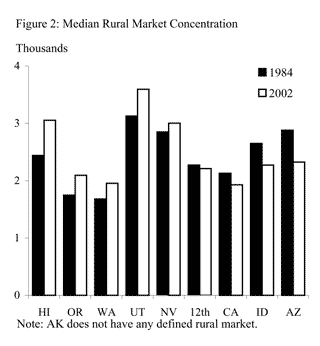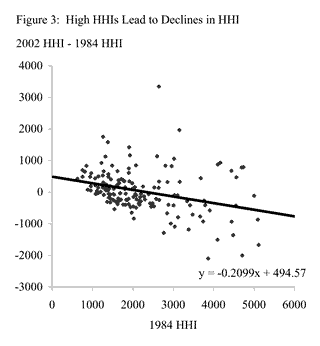As the banking industry has consolidated in recent years, the number of banking organizations in the U.S. and in the Twelfth Federal Reserve District has declined dramatically. This consolidation trend raises public policy issues because of its implications for concentration and therefore competition in local banking markets.
- Why look at concentration?
- What influences concentration?
- What happened to concentration in the Twelfth District overall?
- The picture does vary some among the states
- Conclusion
- References
As the banking industry has consolidated in recent years, the number of banking organizations in the U.S. and in the Twelfth Federal Reserve District has declined dramatically. This consolidation trend raises public policy issues because of its implications for concentration and therefore competition in local banking markets. Specifically, mergers between banks in the same local market increase local banking market concentration, which, in some instances, can weaken competition. To some degree, market forces work to keep a local banking market from remaining highly concentrated for too long: other banks tend to move into concentrated markets to seize the potential pricing advantages, and as they do, concentration declines. In addition, antitrust enforcement, carried out in part by the Federal Reserve, helps limit increases in concentration in local markets due to mergers.
This Economic Letter discusses what has happened to local banking market concentration in the Twelfth District over the last 18 years. In urban markets, concentration has not increased too much, and, in rural markets, it has declined. Although concentration has increased appreciably within urban or rural markets in some individual states, concentration should eventually decline in those areas, as their enhanced potential for profits attracts the entry of new banks.
Concentration measures the degree to which a market is dominated by just a few firms. Increases in concentration tend to decrease competition, leaving consumers facing poorer service, higher fees, higher loan interest rates, and lower deposit interest rates. Theoretically, in highly concentrated markets, dominant firms can increase their profits by engaging in strategic behavior such as price leadership; this would be impossible in a perfectly competitive market. The link between concentration and competition in banking also has an empirical foundation. In research based on data from the 1980s, Berger and Hannan (1989) found that, after controlling for other factors that might affect the results, deposit interest rates tended to be lower in metropolitan areas where the banking industry was relatively concentrated. Using data on loan rates from 20 cities in 1987 and 1988, Rhoades (1992) similarly found that mortgage interest rates tended to be higher in cities where concentration was relatively high. Finally, based on data from 1975 to 1998, Pilloff and Rhoades (2002) found that local market concentration is positively and significantly related to bank profitability. But, based on analysis conducted at the Federal Reserve Bank of San Francisco, it appears that it is mainly among highly concentrated markets that increases in concentration have a statistically significant effect on profitability.
What influences concentration?
Mergers are an important influence on concentration. The banking industry saw tremendous consolidation between 1984 and 2002, with the number of independent bank and thrift organizations in the U.S. falling by almost half, from about 15,000 to about 8,000.
From a public policy perspective, a key concern is the impact of mergers on concentration in local banking markets. A local urban banking market typically encompasses a metropolitan area, while a local rural market encompasses a number of rural communities that are economically linked. Survey evidence on where people do their banking and research linking local banking market concentration and prices suggest that, despite technological advances that have enabled retail customers to bank at a distance, they still largely get their banking services from local banks.
How do we assess the effects of mergers on concentration in local banking markets? The enforcement of antitrust statutes regarding changes in concentration in local banking markets resulting from mergers uses a measure of concentration called the Herfindahl-Hirschman index (HHI), which is the sum of the squares of the individual percent market shares of all the participants in a market. For example, a market consisting of four firms with market shares of 30%, 30%, 20%, and 20%, has an HHI of 2,600. This is a rather high HHI, but not unheard of in rural areas. Given the number of firms in a market, the HHI is at its minimum when all the firms have equal market shares. By itself, a merger between two banks operating in the same local market increases concentration. Using the above example, a merger between the two banks with 20% market shares would increase the HHI from 2,600 to 3,400.
Enforcement of antitrust statutes by the Federal Reserve, the other banking regulators, and the Department of Justice (DOJ) limits increases in concentration due to mergers. The DOJ divides the spectrum of market concentration into three roughly delineated categories that can be broadly characterized as unconcentrated (HHI below 1,000), moderately concentrated (HHI 1,000-1,800), and highly concentrated (HHI above 1,800). With respect to bank mergers, the DOJ’s merger guidelines say that if the change in the HHI in any local market would be greater than 200 and the post-merger market would have an HHI of at least 1,800, then the merger could “create or enhance market power or facilitate its exercise.” Changes smaller than 200 points are deemed to be, in general, of little economic significance.
When the guidelines are exceeded, the regulatory approval of a merger may require divesting some of the branches of the acquiring and/or the target bank in the affected local markets to a third party in order to make the resulting changes in concentration and post-merger concentration levels acceptable. At the same time, even if the merger breaches the guidelines, mitigating factors may argue for approval in a particular market. For example, the relevant market may have faster population growth than similar markets in the state, indicating the likelihood of a higher than average increase in the demand for banking services. In such a case, the market would be expected to attract new entrants at an above average rate, which would tend to alleviate the increase in concentration due to the merger.
Factors other than mergers and antitrust enforcement also influence concentration. For example, during the banking crisis of the late 1980s and early 1990s, the number of bank and thrift failures hit the highest levels seen since the Great Depression. These closures gave an instant boost to the market shares of the remaining participants, exerting upward pressure on concentration.
Of course, new banks are continually forming and existing banks are continually branching into new markets, thus exerting downward pressure on concentration. For example, according the Federal Deposit Insurance Corporation, the average annual rate at which the commercial banking industry added new charters between 1984 and 2002 was about 1.5%. And the number of commercial bank branches grew about 31% between 1984 and 2002. In some local markets, the total number of depository institutions has even increased. Natural population growth may have encouraged the opening of new banks and branches, given that banks and branches have minimum sizes at which they can be profitable.
What happened to concentration in the Twelfth District overall?
The trend in bank consolidation has been clear in the Twelfth District. Between 1984 and 2002, the number of bank and thrift organizations operating in the District declined from 1,090 to 574.
Given the link between local market concentration and competition, the consolidation in the District, and the various influences on concentration, it is important to investigate what actually has happened to concentration in local banking markets in the Twelfth District.
As it turns out, on balance, increases in concentration in Twelfth District urban markets have not been very large, and concentration in rural markets actually has declined slightly. In the 62 defined Twelfth District urban markets, the median local market HHI increased 167 points, from 1,398 to 1,565 between 1984 and 2002. So, at the median, urban markets in the Twelfth District remained moderately concentrated. In the 97 defined rural markets, the median HHI decreased 61 points, from 2,273 in 1984 to 2,212 in 2002.
The picture does vary some among the states



Median concentration in urban and rural markets in some individual states did increase more than 200 points to a level above 1,800. Figure 1 shows median urban market HHIs for the individual states and the District, with states and the District ranked by the percent increase in the median urban market HHI (descending order); Figure 2 shows the analogous statistics for rural markets. At the median, HHIs in urban markets in Utah, Alaska, and Arizona increased by more than 200 points to a level above 1,800; HHIs in rural markets in Hawaii, Oregon, Washington, and Utah also did so.
Theoretically, market forces should impose a kind of “self-correcting” mechanism on concentration, implying that concentration should not rise inexorably. When concentration rises, profitability rises, and this should attract new entry, thereby decreasing concentration. Figure 3, which presents a scatter plot depicting changes in concentration between 1984 and 2002 vs. concentration in 1984 for the local banking markets in the Twelfth District, supports the theory. It suggests that when concentration is high enough to begin with, it does tend to be followed by decreases in concentration in the long run; moreover, the higher the initial concentration, the larger the decreases. (Because antitrust enforcement tends to limit increases in concentration due to mergers for highly concentrated markets, but not for unconcentrated markets or most moderately concentrated markets, antitrust enforcement likely also contributes to the downward sloping relationship seen in Figure 3.)
The theory is further supported by statistical analysis which finds that the linear relationship derived from the data and shown in Figure 3 is statistically significant not only for Twelfth District local markets as a whole but also for urban and rural subsets of Twelfth District local markets. (Rhoades (2000) obtains a similar result for the country as a whole.) The tendency for high initial concentration to be followed by decreases in concentration likely also explains why District urban markets saw a concentration increase and rural markets saw a concentration decrease over the last 18 years–namely, rural markets were more concentrated to begin with.
Finally, the theory is borne out when we look across groups of states that had larger or smaller increases in concentration than the District as a whole. For example, consider urban markets in states that had a larger increase in concentration than the District as a whole (i.e., states to the left of the District in Figure 1). The median 1984 HHI for these markets was 1,322, compared with 1,406 for urban markets in states that had a smaller increase in concentration. Next, consider rural markets in states that had a larger increase in concentration than the District as a whole (i.e., states to the left of the District in Figure 2). The median 1984 HHI for these markets was 2,159, compared with 2,406 for rural markets in states that had a smaller increase in concentration.
The net result of various influences on concentration in local banking markets over the past 18 years has been a modest increase in concentration for Twelfth District urban markets and a decrease in concentration in rural markets. Although urban or rural markets in some individual states do present exceptions to the overall Twelfth District results, with relatively large changes in concentration to relatively high levels, these regions should show declines in concentration in their turn.
Liz Laderman
Economist
References
Berger, Alan, and Timothy Hannan. 1989. “The Price-Concentration Relationship in Banking.” Review of Economics and Statistics 71 pp. 291-299.
Pilloff, Steven J., and Stephen A. Rhoades. 2002. “Structure and Profitability in Banking Markets.” Review of Industrial Organization 20 pp. 81-98.
Rhoades, Stephen A. 1992. “Evidence on the Size of Banking Markets from Mortgage Loan Rates in Twenty Cities.” Federal Reserve Bulletin 78 pp. 117-118.
Rhoades, Stephen A. 2000. “Bank Mergers and Banking Structure in the United States, 1980-98.” Board of Governors of the Federal Reserve System Staff Study 174.
Opinions expressed in FRBSF Economic Letter do not necessarily reflect the views of the management of the Federal Reserve Bank of San Francisco or of the Board of Governors of the Federal Reserve System. This publication is edited by Anita Todd and Karen Barnes. Permission to reprint portions of articles or whole articles must be obtained in writing. Please send editorial comments and requests for reprint permission to research.library@sf.frb.org